Estimated reading time: 6 minutes
Words and pictures by Chipps Chippendale
Getting the first review of a Maverick bike in the UK, and possibly Europe, took all the string pulling we could muster. But it was definitely worth the effort. Not only is it one of the most expensive, luxury bikes out there – a cycling Aston Martin, but it also works as well as you would expect.
Paul Turner (left, the man behind Rockshox, not to be confused with David Turner of Turner bikes) first showed a prototype of his design a year ago at the season opening Sea Otter race, though it’s not the first time he’s dabbled in rear suspension. Remember that bike that Tomac raced? With the funny pull shock under the downtube? Paul was involved in that too.
Latest Singletrack Merch
Buying and wearing our sustainable merch is another great way to support Singletrack

But back to the bike at hand. Luckily we got some time on the bike on some serious off-road before the foot and mouth closedown, and it was one of the bikes in our Nuclear road trip.
If you’re having problems understanding just how it works, here’s a go at explaining it (for a better idea, look on www.maverickamerican.com where they have an animated gif of it working). The bike looks initially like a sort of Unified Rear Triangle, though it’s more complicated than that. The bottom ‘corner’ of the main triangle holds a pivot. To this is attached the very nice magnesium casting that holds the BB shell (and front mech routing for the plate type XTR front mech). Behind this is another pivot that holds the chainstays and the bottom of the custom built rear shock. At the top of the shock body are the seatstays.
Latest Stories
The bike is made from some very swish Easton tubes – the production one is anodised a coppery colour – and the eagle eyed among you might notice the Easton Rad top tube used the other way round to normal to help create that striking seatpin area.
Trail thoughts

As you hit a bump, the wheel moves up and back. The bottom bracket (and therefore the seat/pedal position) moves a small amount (up to 30mm), though not in a way that any of our testers noticed. It’s a semi-Unified Rear Triangle kind of design, though the BB shell is between two pivots, rather than being behind one. There’s only a little noticeable difference between seated and standing on descents.
The first thing that every single tester noticed was how well the bike climbed – it climbs like nothing you’ve ever ridden.
There’s no bob in any gear, but the suspension moves well enough when the going gets rough. The geometry of the bike is perfectly suited to the custom valved Psylos and the steering is sharp, even on the steepest pitches. For epic Alpine road climbing, you can dial in a near lockout on the fork for a great climbing machine – it’s not a total lock, like on production Psylos, ‘we don’t believe in lockout’ said Maverick spokes-geezer Dave-O. The extent of the custom tuning is secret, though we do know they machine up a new, multi profiled compression valve needle. Being Psylo Race forks, they have a lightweight air spring rather than a coil.
The rear suspension is an air- assisted coil spring. The damping is adjustable with a simple knob and the low pressure air spring adds a noticeable amount of cush. There’s a sensible concertina rubber boot to keep the crap off the shock, which is positioned perfectly to catch the crud.
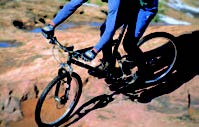
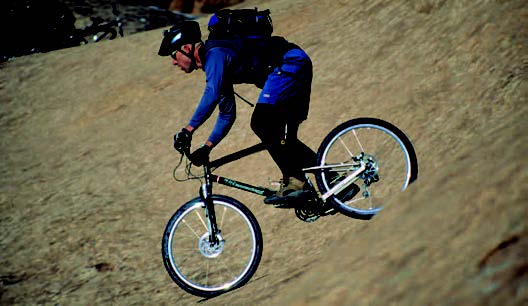
Downhill, the forks remain super sweet and the bike continues to handle wonderfully. The rear suspension travel is good, though it doesn’t feel like it has four inches of travel. On big hit stuff, the bike was a little undergunned, but everything else it handles with aplomb.
It doesn’t descend as well as, say, a Sub5, though the climbing and general trail manners put it into another league. Everyone who rode this bike loved it. We really did have to wrench it out of the desperate, gripping hands of tearful testers.
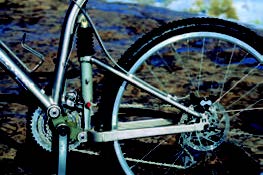
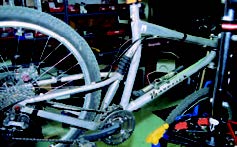
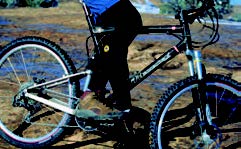
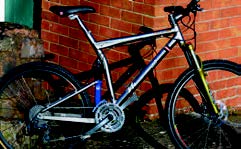
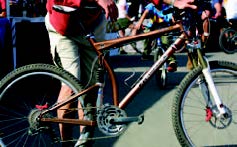
It’s been a while since I’ve looked around the room and wondered what I could sell in order to afford to buy a test bike, but this one got me thinking. The ride, the looks and, well yes, the exclusivity make the Maverick quite a catch. Don’t expect to see one on your local trails any time soon. The main reason will be the price – you will have to search down the back of the sofa for around $3,500 – this will buy you the frame, custom fork, E-clamp XTR front mech, custom machined seat clamp and a seatpost. Maverick will also throw in a logo beanie and a pair of socks. Oh, and there’s probably a waiting list already. Having seen Paul at the Sea Otter, complete with the first of the production frames, we saw that the frame has been tidied up a little from our prototype – the pivot mounts have been enlarged and the rear shock looks a lot neater, now sporting its Fox sticker, complete with nicer adjuster knob. Paul’s frame was also finished in a sweet, anodised copper colour. The plan is to build 350 of these beauties this year, with at least one ‘medium sized manufacturer’ licensing the design for 2002 and possibly a couple of huge firms looking into it for the future. So, even if you don’t get to ride one of these, you still might find one in your future.
And that’s only going to be a Good Thing.
Singletrack Recommended Deals – Wheels
Story tags





